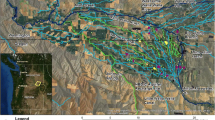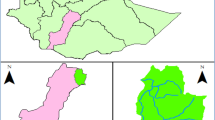Abstract
Often there are a number of criteria that must be considered when evaluating water resource management options, for example both water quantity and quality issues. Each criterion generally requires a separate model to assess the outcomes from different possible scenarios. Each model will have its own uncertainties and limitations, and the combination of all of these considerations can make the identification of acceptable, let alone optimal, options difficult. In this work, a resources management problem to identify the optimal operation of a large drainage network to support ecosystems at a number of key wetlands has been considered. These ecological outcomes were assessed by the ability to deliver sufficient volumes of water below important salinity thresholds. It was found that even with an unknown volume of water available, the optimal operations of the drainage network were generally constant. For the majority of wetlands considered, the ability to supply sufficient water below a given salinity threshold was mostly insensitive to uncertainty in the contributing groundwater salinity. However, in some wetlands, water of desirable salinity levels was unlikely to be available for all scenarios at one target wetland, the variability in groundwater salinity considered had a large influence on the availability of water of suitable quality. This work highlights the importance of keeping the modelling objectives in mind when considering the outputs and uncertainties involved in integrated modelling assessment.















Similar content being viewed by others
References
Boughton W (2004) The Australian water balance model. Environ Model Softw 19(10):943–956
Chiew FHS, Peel MC, Western AW (2002) Application and testing of the simple rainfall-runoff model SIMHYD. In: Singh VP, Frevert D (eds) Mathematical models of small watershed hydrology and applications. Water Resources Publications, Highlands Ranch, pp 335–367
Chiew FHS, Young WJ, Cai W, Teng J (2011) Current drought and future hydroclimate projections in southeast Australia and implications for water resources management. Stoch Environ Res Risk Assess 25(4):601–612. doi:10.1007/s00477-010-0424-x
Coff BE, Ditty NJ, Gee MC, Szemis JM, Maier HR, Dandy GC, Gibbs MS (2009) Relating catchment attributes to parameters of a salt and water balance model. Paper presented at the 18th World IMACS Congress and MODSIM09 International Congress on Modelling and Simulation, Cairns, 13–17 July
Croke BFW, Ticehurst JL, Letcher RA, Norton JP, Newham LTH, Jakeman AJ (2007) Integrated assessment of water resources: Australian experiences. Water Resour Manag 21(1):351–373. doi:10.1007/s11269-006-9057-8
Department for Water (2010) South east water science review. Lower Limestone Coast Water Allocation Plan Taskforce, Adelaide
Department of Water Land and Biodiversity Conservation (2007) Soils of South Australia’s Agricultural Lands. Soil and Land Information, Department of Water, Land and Biodiversity Conservation, Adelaide
Ecological Associates (2009) Estimation of water requirements of wetlands in the South East of South Australia. Department of Water, Land and Biodiversity Conservation, Adelaide
Fleming MJ, Neary V (2004) Continuous hydrologic modeling study with the hydrologic modeling system. J Hydrol Eng 9(3):175–183
Gibbs MS, Goodman A, Partington DJ, Dandy GC, Maier HR (2008) Dryland salinity decision support systems in data-scarce regions. Paper presented at the Water Down Under 2008, Adelaide, 14–17 April
Gibbs MS, Maier HR, Dandy GC (2012) A generic framework for regression regionalization in ungauged catchments. Environ Model Softw 27–28:1–14. doi:10.1016/j.envsoft.2011.10.006
Gilfedder M, Rassam DW, Stenson MP, Jolly ID, Walker GR, Littleboy M (2012) Incorporating land-use changes and surface-groundwater interactions in a simple catchment water yield model. Environ Model Softw 38:62–73. doi:10.1016/j.envsoft.2012.05.005
Goodman AM, Ganf GG, Dandy GC, Maier HR, Gibbs MS (2010) The response of freshwater plants to salinity pulses. Aquat Bot 93(2):59–67. doi:10.1016/j.aquabot.2010.03.004
Goodman AM, Ganf GG, Maier HR, Dandy GC (2011) The effect of inundation and salinity on the germination of seed banks from wetlands in South Australia. Aquat Bot 94(2):102–106. doi:10.1016/j.aquabot.2010.11.003
Herron N, Croke B (2009) Including the influence of groundwater exchanges in a lumped rainfall-runoff model. Math Comput Simul 79(9):2689–2700. doi:10.1016/j.matcom.2008.08.007
Ivkovic KM, Letcher RA, Croke BFW (2009) Use of a simple surface-groundwater interaction model to inform water management. Aust J Earth Sci 56(1):71–80. doi:10.1080/08120090802541945
Jeffrey SJ, Carter JO, Moodie KB, Beswick AR (2001) Using spatial interpolation to construct a comprehensive archive of Australian climate data. Environ Model Softw 16(4):309–330. doi:10.1016/s1364-8152(01)00008-1
Le Moine N, Andreassian V, Perrin C, Michel C (2007) How can rainfall-runoff models handle intercatchment groundwater flows? Theoretical study based on 1040 French catchments. Water Resour Res 43(6):W06428. doi:W0642810.1029/2006wr005608
Lyne V, Hollick M (1979) Stochastic time-variable rainfall-runoff modelling. Paper presented at the Institute of Engineers Australia National Conference, Canberra
Montazeri M, Gibbs MS, Bloss C, Way D, Wood C (2011) Integrated Modelling of Water Delivery Options for the Coorong South Lagoon. Paper presented at the MODSIM 2011, 19th International Congress on Modelling and Simulation, Perth, 12–16 December
Nathan RJ, McMahon TA (1990) Evaluation of automated techniques for base-flow and recession analyses. Water Resour Res 26(7):1465–1473. doi:10.1029/WR026i007p01465
Priestley C, Taylor R (1972) On the assessment of surface heat flux and evaporation using large-scale parameters. Mon Weather Rev 100(2):81–82
Rassam DW (2011) A conceptual framework for incorporating surface-groundwater interactions into a river operation-planning model. Environ Model Softw 26(12):1554–1567. doi:10.1016/j.envsoft.2011.07.019
Ravalico JK, Maier HR, Dandy GC (2009) Sensitivity analysis for decision-making using the MORE method—a Pareto approach. Reliab Eng Syst Saf 94(7):1229–1237. doi:10.1016/j.ress.2009.01.009
Ravalico JK, Dandy GC, Maier HR (2010) Management option rank equivalence (MORE): a new method of sensitivity analysis for decision-making. Environ Model Softw 25(2):171–181. doi:10.1016/j.envsoft.2009.06.012
Scharffenberg W, Fleming MJ (2009) Hydrologic modeling system HEC-HMS user’s manual. Hydrologic Engineering Center, Davis
Taskinen A, Sirvio H, Bruen M (2008) Modelling effects of spatial variability of saturated hydraulic conductivity on autocorrelated overland flow data: linear mixed model approach. Stoch Environ Res Risk Assess 22(1):67–82. doi:10.1007/s00477-006-0099-5
Tuteja NK, Beale G, Dawesc W, Vaze J, Murphy B, Barnett P, Rancic A, Evans R, Geeves G, Rassam DW, Miller M (2003) Predicting the effects of landuse change on water and salt balance—a case study of a catchment affected by dryland salinity in NSW, Australia. J Hydrol 283(1–4):67–90
Zhang YY, Xia J, Shao QX, Zhai XY (2013) Water quantity and quality simulation by improved SWAT in highly regulated Huai River Basin of China. Stoch Environ Res Risk Assess 27(1):11–27. doi:10.1007/s00477-011-0546-9
Acknowledgments
This work was supported by the Australian Research Council through its Linkage scheme and the South Australian Department of Environment, Water and Natural Resources (DEWNR) as industry partners, as well as the Goyder Institute for Water Research. The authors would like to acknowledge the assistance of the Department of Environment, Water and Natural Resources and South East South Eastern Water Conservation and Drainage Board staff in this work.
Author information
Authors and Affiliations
Corresponding author
Rights and permissions
About this article
Cite this article
Gibbs, M.S., Dandy, G.C. & Maier, H.R. Assessment of the ability to meet environmental water requirements in the Upper South East of South Australia. Stoch Environ Res Risk Assess 28, 39–56 (2014). https://doi.org/10.1007/s00477-013-0735-9
Published:
Issue Date:
DOI: https://doi.org/10.1007/s00477-013-0735-9




